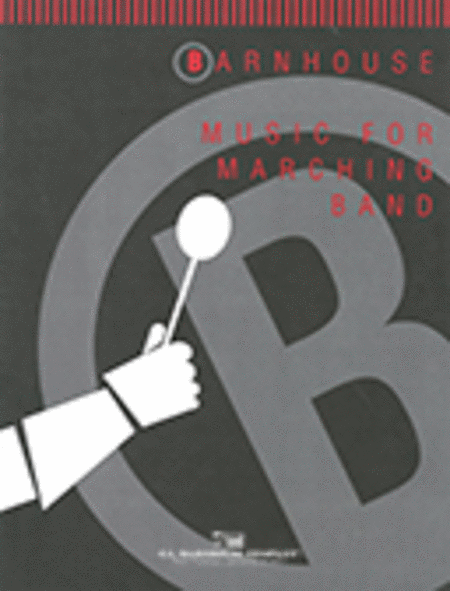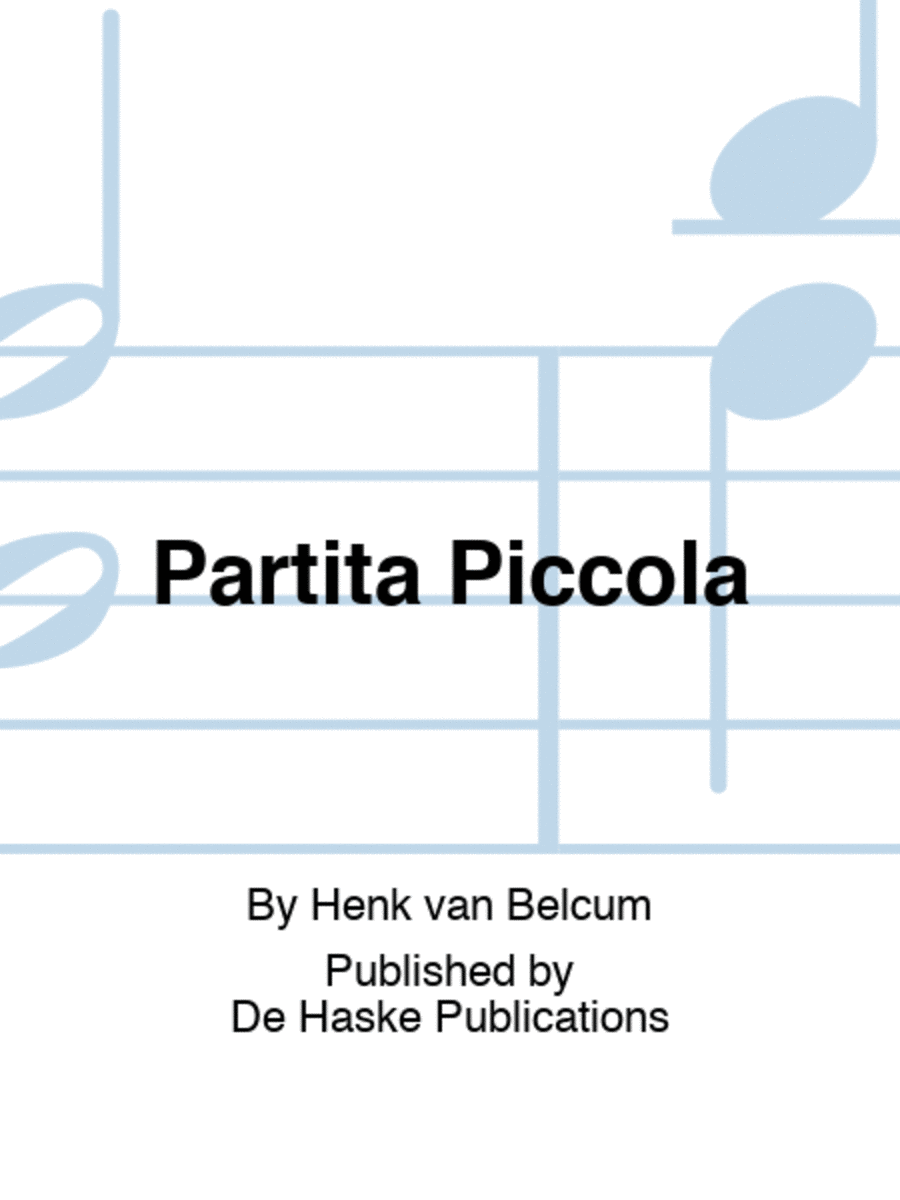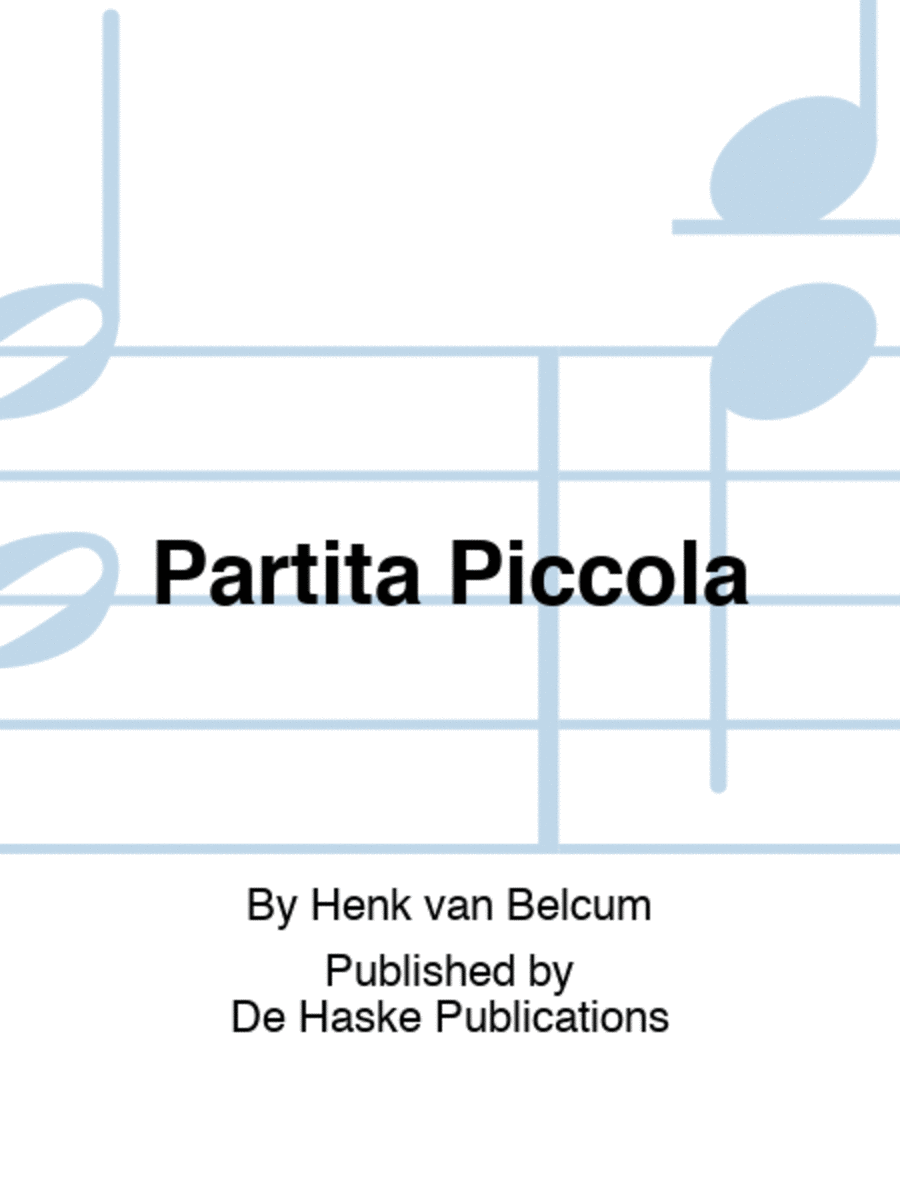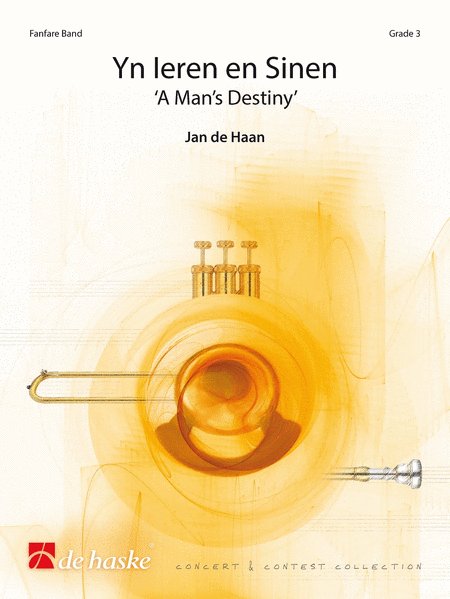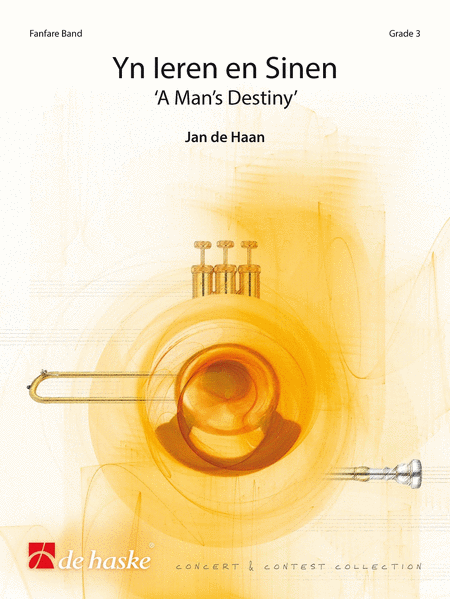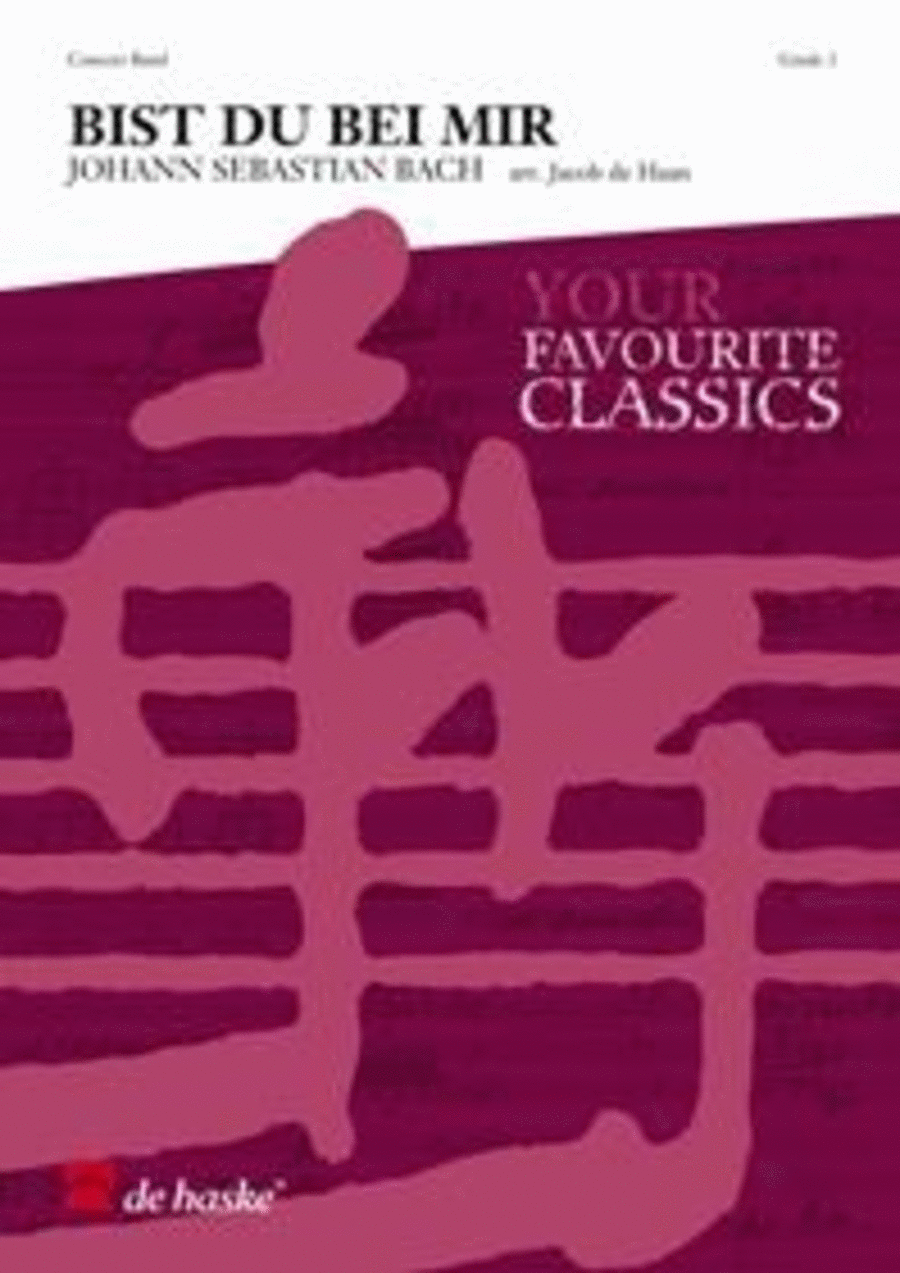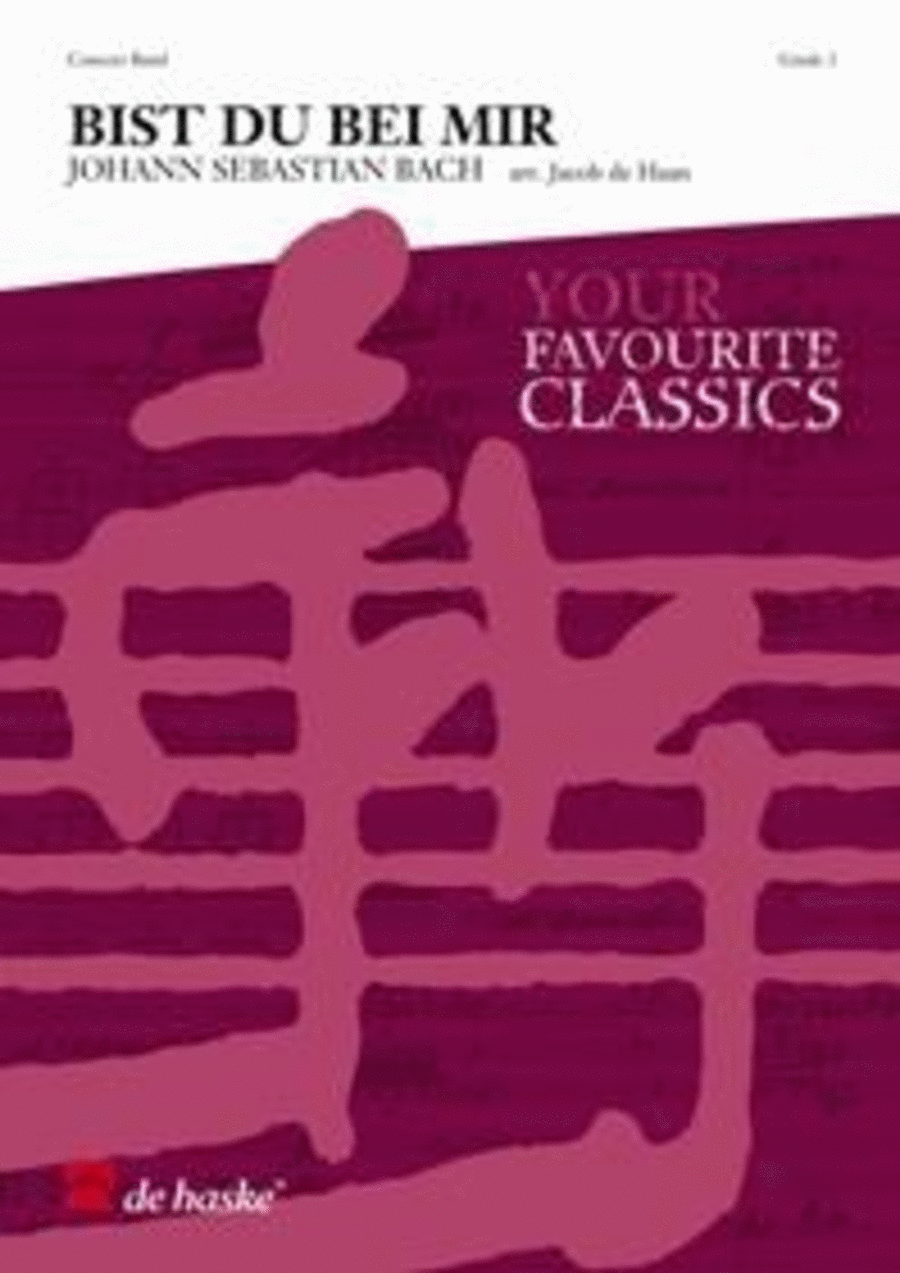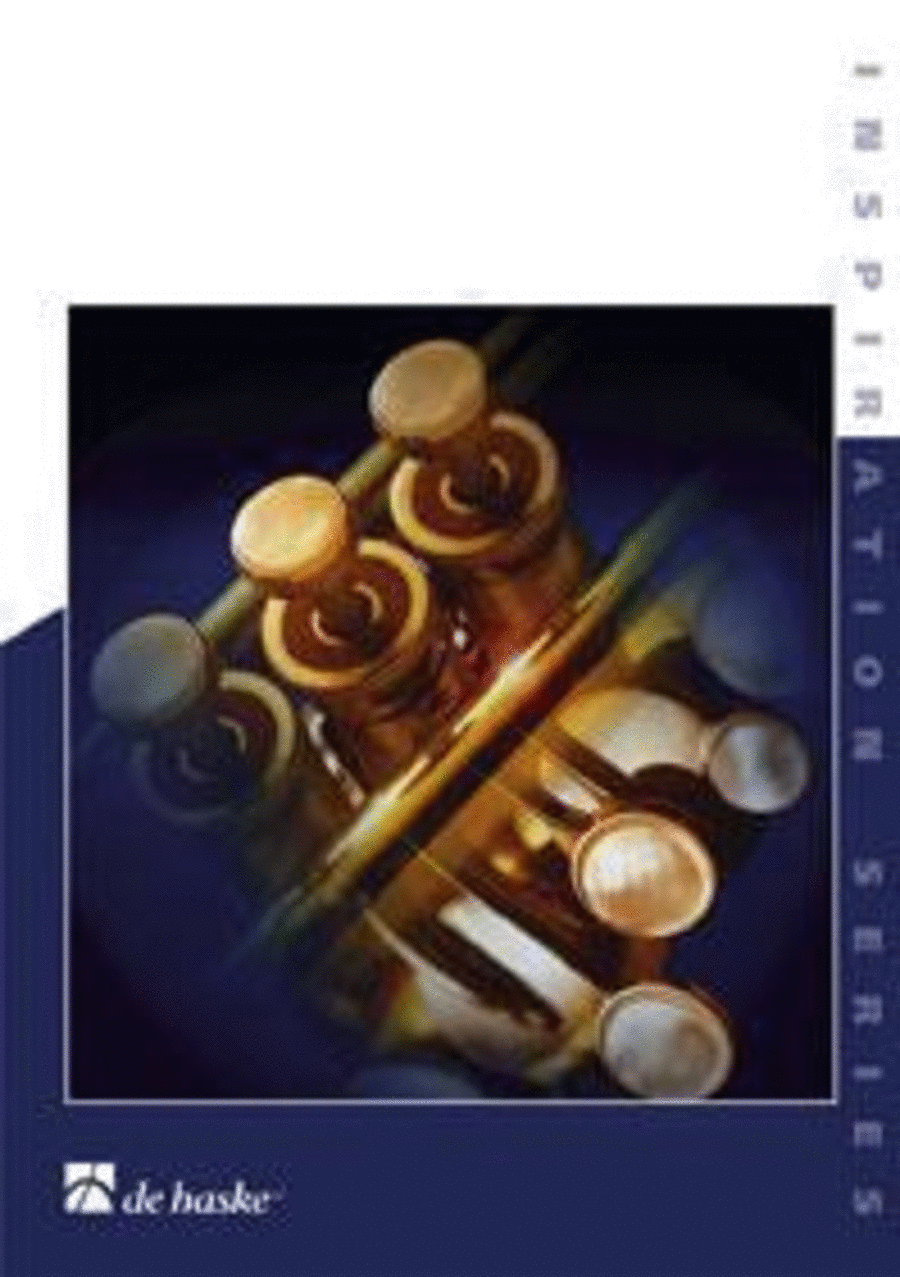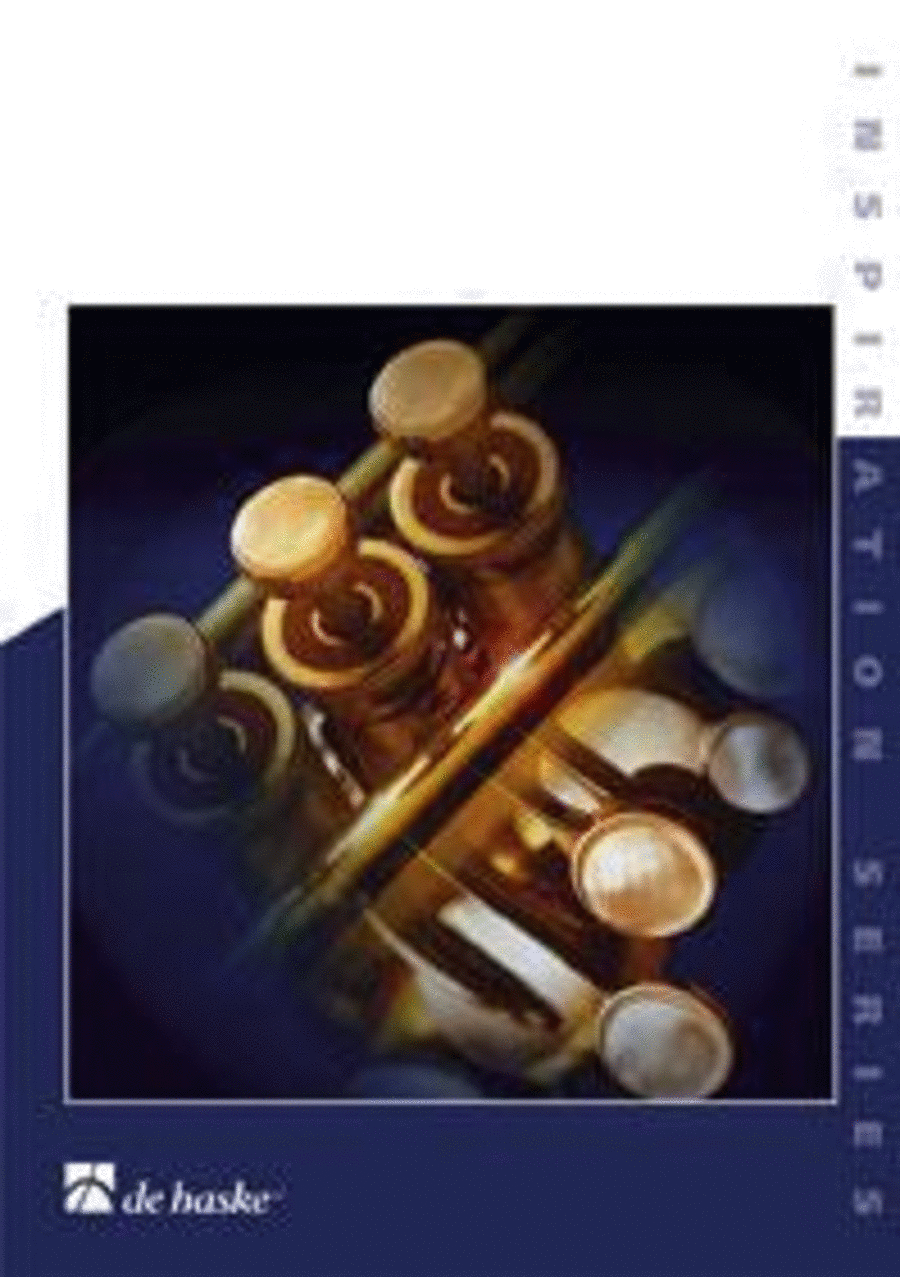|
| Canon Fire
Fanfare [Conducteur et Parties séparées] - Facile
C.L. Barnhouse
Grade 2 SKU: CL.058-2540-00 Composed by Johann Pachelbel. Arranged by A. ...(+)
Grade 2 SKU:
CL.058-2540-00
Composed by Johann
Pachelbel. Arranged by A.
Clark. Marching Band.
Score and set of parts.
Composed 1993. C.L.
Barnhouse #058-2540-00.
Published by C.L.
Barnhouse
(CL.058-2540-00).
Based on
Pachelbel's Canon in D
Classical. $50.00 - Voir plus => AcheterDélais: 1 to 2 weeks | | | |
| Partita Piccola
Fanfare [Conducteur] - Facile
De Haske Publications
Fanfare Band - Grade 2.5 SKU: BT.DHP-1012706-120 Composed by Henk van Bel...(+)
Fanfare Band - Grade 2.5
SKU:
BT.DHP-1012706-120
Composed by Henk van
Belcum. Performance
Series. Concert Piece.
Score Only. Composed
2001. De Haske
Publications #DHP
1012706-120. Published by
De Haske Publications
(BT.DHP-1012706-120).
As the title
suggests, this work is a
partita: it consists of a
number of variations on a
chorale melody. The
partita has been popular
for centuries, especially
when it comes to organ
music. Henk van Belcum,
who is active in the
choir world, chose for
his Partita Piccola the
German hymn Wunderbarer
König as a starting
point. Partita Piccola
consists of four
variations and a choral
setting. After a majestic
opening fanfare, the
second variation follows,
based on a canon by
Pachelbel.
Händel’s
Sarabande is the basis of
the third variation. Next
comes the chorale
setting, after which the
work ends festively with
a dance that has been
written in the form of a
courante. PartitaPiccola
is an asset for church
services and for concert
platforms.
Die
Partita, seit
Jahrhunderten ein fester
und beliebter Bestandteil
der Orgelliteratur,
besteht aus einer Anzahl
Variationen zu einer
Choralmelodie. Für
seine Partita
Piccola nahm sich
Henk van Belcum die
deutsche Hymne
Wunderbarer König als
Vorlage. Die Partita
Piccola besteht aus vier
Variationen und einer
Choralbearbeitung, die
auch einzeln für den
Gottesdienst verwendet
werden kann.Auf eine
würdevolle
Eröffnungsfanfare
folgen neben der
Choralbearbeitung
Variationen zu einem
Kanon Pachelbels und zu
Händels Sarabande.
Abgerundet wird das Werk
schließlich durch eine
festliche Courante. Die
Partita Piccola
ist eine Bereicherung
für den Gottesdienst
und
dieKonzertbühne. $26.95 - Voir plus => AcheterDélais: 2 to 3 weeks | | | |
| Partita Piccola
Fanfare [Conducteur et Parties séparées] - Facile
De Haske Publications
Fanfare Band - Grade 2.5 SKU: BT.DHP-1012706-020 Composed by Henk van Bel...(+)
Fanfare Band - Grade 2.5
SKU:
BT.DHP-1012706-020
Composed by Henk van
Belcum. Performance
Series. Concert Piece.
Set (Score & Parts).
Composed 2001. De Haske
Publications #DHP
1012706-020. Published by
De Haske Publications
(BT.DHP-1012706-020).
As the title
suggests, this work is a
partita: it consists of a
number of variations on a
chorale melody. The
partita has been popular
for centuries, especially
when it comes to organ
music. Henk van Belcum,
who is active in the
choir world, chose for
his Partita Piccola the
German hymn Wunderbarer
König as a starting
point. Partita Piccola
consists of four
variations and a choral
setting. After a majestic
opening fanfare, the
second variation follows,
based on a canon by
Pachelbel.
Händel’s
Sarabande is the basis of
the third variation. Next
comes the chorale
setting, after which the
work ends festively with
a dance that has been
written in the form of a
courante. PartitaPiccola
is an asset for church
services and for concert
platforms.
Die
Partita, seit
Jahrhunderten ein fester
und beliebter Bestandteil
der Orgelliteratur,
besteht aus einer Anzahl
Variationen zu einer
Choralmelodie. Für
seine Partita
Piccola nahm sich
Henk van Belcum die
deutsche Hymne
Wunderbarer König als
Vorlage. Die Partita
Piccola besteht aus vier
Variationen und einer
Choralbearbeitung, die
auch einzeln für den
Gottesdienst verwendet
werden kann.Auf eine
würdevolle
Eröffnungsfanfare
folgen neben der
Choralbearbeitung
Variationen zu einem
Kanon Pachelbels und zu
Händels Sarabande.
Abgerundet wird das Werk
schließlich durch eine
festliche Courante. Die
Partita Piccola
ist eine Bereicherung
für den Gottesdienst
und
dieKonzertbühne. $137.95 - Voir plus => AcheterDélais: 2 to 3 weeks | | | |
| Yn Ieren en Sinen
Fanfare [Conducteur et Parties séparées] - Facile
De Haske Publications
Fanfare Band - Grade 3 SKU: BT.DHP-1185826-020 'A Man's Destiny'. ...(+)
Fanfare Band - Grade 3
SKU:
BT.DHP-1185826-020
'A Man's Destiny'.
Composed by Jan de Haan.
Concert and Contest
Collection Brass Band en
Fanfare. Concert Piece.
Set (Score & Parts).
Composed 2018. De Haske
Publications #DHP
1185826-020. Published by
De Haske Publications
(BT.DHP-1185826-020).
English-German-French-
Dutch. ‘Yn
Ieren en Sinen’
(‘with much
conviction’) was
commissioned by CMV
Harmonie Sneek
(Friesland, The
Netherlands) to mark
their 95th anniversary.
As requested by the
commissioning party, the
composer based this work
on the life of a former
member of the band, who
played flugelhorn until
the age of 86. Music was
very important in the
eventful life of the man
in question. A passionate
musician, he had a great
love for chorale
melodies, and his
favourite piece, the
famous Canon by the
English composer Thomas
Tallis (1505-1585) was
the source of inspiration
for this composition.
Yn Ieren en
Sinen (vanuit volle
overtuiging) is
geschreven in opdracht
van CMV Harmonie Sneek
ter gelegenheid van het
95-jarig jubileum van dat
orkest. Op verzoek van de
opdrachtgever baseerde de
componist het werk op het
leven van een oud-lid van
de vereniging een man die
tot zijn 86e jaar de
bugel bespeelde. Muziek
was erg belangrijk in het
veelbewogen leven van de
man. Als fanatiek
muzikant had hij een
grote liefde voor
koraalmelodieën. Zijn
lievelingslied,
Tallis’
Canon van de Engelse
componist Thomas Tallis
(1505-1585), is dan ook
de inspiratiebron geweest
voor deze compositie. $184.95 - Voir plus => AcheterDélais: 2 to 3 weeks | | | |
| Yn Ieren en Sinen
Fanfare [Conducteur] - Facile
De Haske Publications
Fanfare Band - Grade 3 SKU: BT.DHP-1185826-120 'A Man's Destiny'. ...(+)
Fanfare Band - Grade 3
SKU:
BT.DHP-1185826-120
'A Man's Destiny'.
Composed by Jan de Haan.
Concert and Contest
Collection Brass Band en
Fanfare. Concert Piece.
Score Only. Composed
2018. 43 pages. De Haske
Publications #DHP
1185826-120. Published by
De Haske Publications
(BT.DHP-1185826-120).
English-German-French-
Dutch. ‘Yn
Ieren en Sinen’
(‘with much
conviction’) was
commissioned by CMV
Harmonie Sneek
(Friesland, The
Netherlands) to mark
their 95th anniversary.
As requested by the
commissioning party, the
composer based this work
on the life of a former
member of the band, who
played flugelhorn until
the age of 86. Music was
very important in the
eventful life of the man
in question. A passionate
musician, he had a great
love for chorale
melodies, and his
favourite piece, the
famous Canon by the
English composer Thomas
Tallis (1505-1585) was
the source of inspiration
for this composition.
Yn Ieren en
Sinen (vanuit volle
overtuiging) is
geschreven in opdracht
van CMV Harmonie Sneek
ter gelegenheid van het
95-jarig jubileum van dat
orkest. Op verzoek van de
opdrachtgever baseerde de
componist het werk op het
leven van een oud-lid van
de vereniging een man die
tot zijn 86e jaar de
bugel bespeelde. Muziek
was erg belangrijk in het
veelbewogen leven van de
man. Als fanatiek
muzikant had hij een
grote liefde voor
koraalmelodieën. Zijn
lievelingslied,
Tallis’
Canon van de Engelse
componist Thomas Tallis
(1505-1585), is dan ook
de inspiratiebron geweest
voor deze compositie. $34.95 - Voir plus => AcheterDélais: 2 to 3 weeks | | | |
| Bist Du bei mir
Fanfare [Conducteur] - Facile
De Haske Publications
Fanfare Band - Grade 2 SKU: BT.DHP-1053785-120 Composed by Johann Sebasti...(+)
Fanfare Band - Grade 2
SKU:
BT.DHP-1053785-120
Composed by Johann
Sebastian Bach. Arranged
by Jacob De Haan. Your
Favorite Classics. Score
Only. Composed 2005. 12
pages. De Haske
Publications #DHP
1053785-120. Published by
De Haske Publications
(BT.DHP-1053785-120).
English-German-French-
Dutch. Bist du
bei mir schrieb
Johann Sebastian Bach
für seine zweite Frau
Anna Magdalena. Die
Melodie passt
vorzüglich zum Text
eines unbekannten
Dichters, der besagt,
dass selbst der Tod
keinen Schrecken mehr
birgt, solange nur der
geliebte Mensch da ist.
Jacob de Haan schuf aus
der beliebten,
besinnlichen Melodie eine
gefühlvolle
Bearbeitung für
Blasorchester.
En
1721, Jean-Sébastien
Bach épouse en
secondes noces Anna
Magdalena Wilcken
(1701-1760). Il lui
dédie l’air
Bist du bei mir BWV
508. Le texte a
été écrit par un
poète anonyme. La
notoriété de cet
air reste inégalable
par la sublime tendresse
de la mélodie qui
évolue en parfaite
harmonie avec un texte
puissant dans lequel le
poète nous livre une
belle vision de
l’amour : tant que
l’être aimé
est auprès de nous,
même la mort est
douce. Jacob de Haan a
réalisé ce superbe
arrangement pour
Fanfare.
Nel 1721
Johann Sebastian Bach
sposa in seconde nozze
Anna Magdalena Wilcken.
Le dedica
l’aria Bist du
bei mir BWV 508. La
notoriet di questa aria
è ineguagliabile per
la sua tenerezza che si
evolve in perfetta
armonia con un testo
potente nel quale il
poeta ci regala una bella
visione
dell’amore. Jacob
de Haan ha realizzato un
superlativo arrangiamento
per banda, adatto a tutte
le occasioni. $17.95 - Voir plus => AcheterDélais: 2 to 3 weeks | | | |
| Bist Du bei mir
Fanfare [Conducteur et Parties séparées] - Facile
De Haske Publications
Fanfare Band - Grade 2 SKU: BT.DHP-1053785-020 Composed by Johann Sebasti...(+)
Fanfare Band - Grade 2
SKU:
BT.DHP-1053785-020
Composed by Johann
Sebastian Bach. Arranged
by Jacob De Haan. Your
Favorite Classics. Set
(Score & Parts). Composed
2005. De Haske
Publications #DHP
1053785-020. Published by
De Haske Publications
(BT.DHP-1053785-020).
English-German-French-
Dutch. The song
Bist du bei mir,
geh’ ich mit
Freuden zum Sterben und
zu meiner Ruh’
(BWV 508) was composed by
Johann Sebastian Bach for
his second wife Anna
Magdalena (1701-1760),
who he married in
1721.The popularity of
this song is probably due
to the magnificent,
sensitive melody that
fits wonderfully with the
text, in which a loved
one is told that even
death is beautiful
“as long as you are
there with me.â€
This beautiful
arrangement by Jacob de
Haan is suitable for use
in any
concert.
Het lied
Bist du bei mir,
geh’ ich mit
freuden zum Sterben und
zu meiner Ruh (BWV 508)
werd gecomponeerd door
Johann Sebastian Bach
voor zijn tweede vrouw
Anna Magdalena
(1701-1760), met wie hij
in 1721 trouwde. Dit lied
dankt
zijnongeëvenaarde
populariteit
waarschijnlijk aan de
schitterende, gevoelige
melodie die prachtig
aansluit bij de tekst,
waarin een geliefde te
horen krijgt dat zelfs de
dood mooi is
‘zolang jij bij me
bent’. Dit
prachtige arrangementvoor
blaasorkest, geschreven
door Jacob de Haan, is
geschikt voor vele
gelegenheden.
B
ist du bei mir
schrieb Johann Sebastian
Bach für seine zweite
Frau Anna Magdalena. Die
Melodie passt
vorzüglich zum Text
eines unbekannten
Dichters, der besagt,
dass selbst der Tod
keinen Schrecken mehr
birgt, solange nur der
geliebte Mensch da ist.
Jacob de Haan schuf aus
der beliebten,
besinnlichen Melodie eine
gefühlvolle
Bearbeitung für
Blasorchester.
En
1721, Jean-Sébastien
Bach épouse en
secondes noces Anna
Magdalena Wilcken
(1701-1760). Il lui
dédie l’air
Bist du bei mir BWV
508. Le texte a
été écrit par un
poète anonyme. La
notoriété de cet
air reste inégalable
par la sublime tendresse
de la mélodie qui
évolue en parfaite
harmonie avec un texte
puissant dans lequel le
poète nous livre une
belle vision de
l’amour : tant que
l’être aimé
est auprès de nous,
même la mort est
douce. Jacob de Haan a
réalisé ce superbe
arrangement pour
Fanfare.
Nel 1721
Johann Sebastian Bach
sposa in seconde nozze
Anna Magdalena Wilcken.
Le dedica
l’aria Bist du
bei mir BWV 508. La
notoriet di questa aria
è ineguagliabile per
la sua tenerezza che si
evolve in perfetta
armonia con un testo
potente nel quale il
poeta ci regala una bella
visione
dell’amore. Jacob
de Haan ha realizzato un
superlativo arrangiamento
per banda, adatto a tutte
le occasioni. $110.95 - Voir plus => AcheterDélais: 2 to 3 weeks | | | |
| The Golden Age
Fanfare [Conducteur et Parties séparées] - Facile
De Haske Publications
Fanfare Band - Grade 3 SKU: BT.DHP-1064079-020 Composed by Kees Schoonenb...(+)
Fanfare Band - Grade 3
SKU:
BT.DHP-1064079-020
Composed by Kees
Schoonenbeek. Inspiration
Series. Concert Piece.
Set (Score & Parts).
Composed 2006. De Haske
Publications #DHP
1064079-020. Published by
De Haske Publications
(BT.DHP-1064079-020).
9x12 inches.
English-German-French-Dut
ch. The Golden
Age is a programmatic
composition in four
movements. I
Overture For the
Netherlands, the
seventeenth century was a
period of great
flourishing in the fields
of economy, culture and
politics; thus it is
called the Golden Age.
Overseas trade boomed,
and the Dutch East India
Company (known as the VOC
by the Dutch) was founded
and expanded to become a
powerful -and, at the
time - modern enterprise.
II ¡Adiós
españoles!(Farewel
l, Spaniards!) In 1567,
the Spanish army invaded,
led by the Duke of Alva.
There was a fierce
resistance against the
Spanish tyranny; toward
the end of the sixteenth
century, the Dutch
proclaimed theRepublic.
However, the Spanish
continued the war. Only
with the Treaty of
Münster in 1648 did
the Dutch get their much
sought-after
independence. This was
also the end of the
Eighty Years’ War.
III Rembrandt’s
Night WatchThe field
of culture, particularly
literature, painting,
sculpture, architecture,
the art of printing, and
cartography developed
fast. It was in the
Golden Age that the
celebrated painter
Rembrandt van Rijn
created his famous Night
Watch. IV The
Admiral Overseas
trade entailed the
colonization of large
areas in Asia, from where
precious products that
yielded lots of money
were brought in.
Surrounding countries
were also involved in
such practices.
Colonizers poached on
each other’s
territories in the
literal and figurative
sense - in this context
the Anglo-Dutch Sea Wars
are legendary. The fourth
movement starts with the
English patriotic song
Rule Britannia, after
which the Dutch Admiral
Michiel de Ruyter makes
the English change their
tune; one can even hear
the roaring of cannons.
When the smoke of battle
has cleared, a small
fragment of a Dutch song
about Michiel de Ruyter
appears, followed by a
fitting closing.
The Golden
Age is een
programmatische
compositie in vier delen.
Overtureverklankt
de Gouden Eeuw, voor
Nederland een periode van
grote bloei. Dan volgt
¡Adiós
españoles! over
het einde van de
Tachtigjarige
Oorlog.Rembrandt�
��s Night Watch
beschrijft de
ontwikkeling op cultureel
gebied: in de Gouden Eeuw
schilderde Rembrandt van
Rijn zijn beroemde
Nachtwacht. Deel
vier, The Admiral,
begint met Rule
Britannia,waarna de
Nederlandse admiraal
Michiel de Ruyter de
Engelsen een toontje
lager laat zingen, er is
zelfs kanongebulder te
horen. Dan klinkt een
fragment van het
Nederlandse liedje dat
aan Michiel de Ruyter is
gewijd, waarna een
passendslot
volgt.
The
Golden Age ist eine
programmatische
Komposition in vier
Sätzen über das so
genannte “Goldene
Zeitalter“ in der
Geschichte der
Niederlande. In dieser
Periode erlebte das Land
eine Blütezeit des
(Ãœbersee-)Handels, der
Kultur und Politik, es
befreite sich von der
spanischen Herrschaft,
brachte Kunstwerke wie
Rembrandt’s
Nachtwache hervor
und entwickelte sich zu
einer Kolonialmacht. Die
Aufmerksamkeit der
Zuhörer ist bei Kees
Schoonenbeeks spannender
musikalischer
Geschichtsstunde
garantiert!
Apr�
�s une guerre qui dura 80
ans, l'Espagne reconnut
finalement
l'indépendance des
Provinces-Unies
néerlandaises, qui
devinrent alors
l’une des plus
importantes puissances
maritimes et
économiques du XVIIe
siècle. Cette
période est connue
sous le nom de Siècle
d’or (The
Golden Age) et
correspond une phase de
développement
exceptionnel des Pays-Bas
tant sur le plan colonial
et militaire que sur le
plan culturel,
intellectuel et
artistique.
Dopo
una guerra che durò 80
anni, la Spagna riconobbe
l’indipendenza
delle Province-Unite
olandesi che divennero
potenze marittime ed
economiche del XVII
secolo. Questo periodo
è conosciuto con il
nome di Secolo
d’Oro (The Golden
Age) e corrisponde ad una
fase di sviluppo
eccezionale dei Paesi
Bassi sia sul piano
coloniale e militare, sia
sul piano culturale,
intellettuale e
artistico. $184.95 - Voir plus => AcheterDélais: 2 to 3 weeks | | | |
| The Golden Age
Fanfare [Conducteur] - Facile
De Haske Publications
Fanfare Band - Grade 3 SKU: BT.DHP-1064079-120 Composed by Kees Schoonenb...(+)
Fanfare Band - Grade 3
SKU:
BT.DHP-1064079-120
Composed by Kees
Schoonenbeek. Inspiration
Series. Concert Piece.
Score Only. Composed
2006. 56 pages. De Haske
Publications #DHP
1064079-120. Published by
De Haske Publications
(BT.DHP-1064079-120).
9x12 inches.
English-German-French-Dut
ch. The Golden
Age is a programmatic
composition in four
movements. I
Overture For the
Netherlands, the
seventeenth century was a
period of great
flourishing in the fields
of economy, culture and
politics; thus it is
called the Golden Age.
Overseas trade boomed,
and the Dutch East India
Company (known as the VOC
by the Dutch) was founded
and expanded to become a
powerful -and, at the
time - modern enterprise.
II ¡Adiós
españoles!(Farewel
l, Spaniards!) In 1567,
the Spanish army invaded,
led by the Duke of Alva.
There was a fierce
resistance against the
Spanish tyranny; toward
the end of the sixteenth
century, the Dutch
proclaimed theRepublic.
However, the Spanish
continued the war. Only
with the Treaty of
Münster in 1648 did
the Dutch get their much
sought-after
independence. This was
also the end of the
Eighty Years’ War.
III Rembrandt’s
Night WatchThe field
of culture, particularly
literature, painting,
sculpture, architecture,
the art of printing, and
cartography developed
fast. It was in the
Golden Age that the
celebrated painter
Rembrandt van Rijn
created his famous Night
Watch. IV The
Admiral Overseas
trade entailed the
colonization of large
areas in Asia, from where
precious products that
yielded lots of money
were brought in.
Surrounding countries
were also involved in
such practices.
Colonizers poached on
each other’s
territories in the
literal and figurative
sense - in this context
the Anglo-Dutch Sea Wars
are legendary. The fourth
movement starts with the
English patriotic song
Rule Britannia, after
which the Dutch Admiral
Michiel de Ruyter makes
the English change their
tune; one can even hear
the roaring of cannons.
When the smoke of battle
has cleared, a small
fragment of a Dutch song
about Michiel de Ruyter
appears, followed by a
fitting closing.
The Golden
Age is een
programmatische
compositie in vier delen.
Overtureverklankt
de Gouden Eeuw, voor
Nederland een periode van
grote bloei. Dan volgt
¡Adiós
españoles! over
het einde van de
Tachtigjarige
Oorlog.Rembrandt�
��s Night Watch
beschrijft de
ontwikkeling op cultureel
gebied: in de Gouden Eeuw
schilderde Rembrandt van
Rijn zijn beroemde
Nachtwacht. Deel
vier, The Admiral,
begint met Rule
Britannia,waarna de
Nederlandse admiraal
Michiel de Ruyter de
Engelsen een toontje
lager laat zingen, er is
zelfs kanongebulder te
horen. Dan klinkt een
fragment van het
Nederlandse liedje dat
aan Michiel de Ruyter is
gewijd, waarna een
passendslot
volgt.
The
Golden Age ist eine
programmatische
Komposition in vier
Sätzen über das so
genannte “Goldene
Zeitalter“ in der
Geschichte der
Niederlande. In dieser
Periode erlebte das Land
eine Blütezeit des
(Ãœbersee-)Handels, der
Kultur und Politik, es
befreite sich von der
spanischen Herrschaft,
brachte Kunstwerke wie
Rembrandt’s
Nachtwache hervor
und entwickelte sich zu
einer Kolonialmacht. Die
Aufmerksamkeit der
Zuhörer ist bei Kees
Schoonenbeeks spannender
musikalischer
Geschichtsstunde
garantiert!
Apr�
�s une guerre qui dura 80
ans, l'Espagne reconnut
finalement
l'indépendance des
Provinces-Unies
néerlandaises, qui
devinrent alors
l’une des plus
importantes puissances
maritimes et
économiques du XVIIe
siècle. Cette
période est connue
sous le nom de Siècle
d’or (The
Golden Age) et
correspond une phase de
développement
exceptionnel des Pays-Bas
tant sur le plan colonial
et militaire que sur le
plan culturel,
intellectuel et
artistique.
Dopo
una guerra che durò 80
anni, la Spagna riconobbe
l’indipendenza
delle Province-Unite
olandesi che divennero
potenze marittime ed
economiche del XVII
secolo. Questo periodo
è conosciuto con il
nome di Secolo
d’Oro (The Golden
Age) e corrisponde ad una
fase di sviluppo
eccezionale dei Paesi
Bassi sia sul piano
coloniale e militare, sia
sul piano culturale,
intellettuale e
artistico. $36.95 - Voir plus => AcheterDélais: 2 to 3 weeks | | | |
| Variations on Shalom Chaverim
Fanfare [Conducteur et Parties séparées] - Facile
Gobelin Music Publications
Fanfare Band - Grade 3 SKU: BT.GOB-000844-020 Composed by Andreas Ludwig ...(+)
Fanfare Band - Grade 3
SKU:
BT.GOB-000844-020
Composed by Andreas
Ludwig Schulte. Set
(Score & Parts). 12
pages. Gobelin Music
Publications #GOB
000844-020. Published by
Gobelin Music
Publications
(BT.GOB-000844-020).
Shalom Chaverim
is an ancient Hebrew
(farewell)song, which was
originally sung at the
end of a celebration or
meeting. It was and is
mostly sung as a round.
Freely translated the
words mean “Goodbye,
friends, goodbye and see
you again!”. The
varying moods at a
parting have been
captured very well by
Andreas Schulte in his
arrangement ‘Variations
on Shalom Chaverim’.
The composer himself says
about the song,
‘Although the melody is
in a minor key, the
overall atmosphere in the
song is positive. one
wishes each other all the
best. Saying goodbye,
however, also hurts. When
you slow down the pace of
the melody and add
‘blue notes’ in the
harmonies, this can be
sensed
immediately.’Schulte
refers here to the first
variation. The second
variation is very intense
with possibly even
deeper-felt emotions.
‘Variations on Shalom
Chaverim’ ends on a
cheerful and positive
note, in fast tempo, and
with oriental elements in
the melody:
‘L'hitra'ot, Shalom’
(See you again, and
farewell!).
Shalom Chaverim
is een oud hebreeuws
(afscheids)lied, dat
oorspronkelijk aan het
eind van een viering of
bijeenkomst gezongen
werd. Dit werd en wordt
meestal in ‘canon’
gedaan. Vrij vertaald
luidt de tekst: ‘Dag
makkers, dag,
totziens!’. De
verschillende stemmingen
bij een afscheid zijn
bijzonder fraai door
Andreas Schulte in zijn
‘Variations on Shalom
Chaverim’ verwerkt.
Zelf zegt de componist
over het lied:
‘Alhoewel de toonsoort
van de melodie in
mineuris, is de teneur
van het lied positief. je
wenst elkaar alle goeds
toe. Maar afscheid doet
soms pijn. Wanneer je het
tempo van de melodie
verlaagt en
‘blue-notes’ toevoegt
in de samenklanken, is
dit direct voelbaar.’
Schultedoelt hiermee op
de eerste variatie. De
tweede variatie is zeer
intens met mogelijk nog
diepere gevoelens. Met
een hoog tempo en
oosterse elementen in de
melodie, eindigt
Variations on Shalom
Chaverim, opgewekt en
positief:‘L'hitra'ot,
Shalom’ (Tot ziens, het
ga je goed!). $137.95 - Voir plus => AcheterDélais: 2 to 3 weeks | | | |
| Variations on Shalom Chaverim
Fanfare [Conducteur] - Facile
Gobelin Music Publications
Fanfare Band - Grade 3 SKU: BT.GOB-000844-120 Composed by Andreas Ludwig ...(+)
Fanfare Band - Grade 3
SKU:
BT.GOB-000844-120
Composed by Andreas
Ludwig Schulte. Score
Only. Gobelin Music
Publications #GOB
000844-120. Published by
Gobelin Music
Publications
(BT.GOB-000844-120).
Shalom Chaverim
is an ancient Hebrew
(farewell)song, which was
originally sung at the
end of a celebration or
meeting. It was and is
mostly sung as a round.
Freely translated the
words mean “Goodbye,
friends, goodbye and see
you again!”. The
varying moods at a
parting have been
captured very well by
Andreas Schulte in his
arrangement ‘Variations
on Shalom Chaverim’.
The composer himself says
about the song,
‘Although the melody is
in a minor key, the
overall atmosphere in the
song is positive. one
wishes each other all the
best. Saying goodbye,
however, also hurts. When
you slow down the pace of
the melody and add
‘blue notes’ in the
harmonies, this can be
sensed
immediately.’Schulte
refers here to the first
variation. The second
variation is very intense
with possibly even
deeper-felt emotions.
‘Variations on Shalom
Chaverim’ ends on a
cheerful and positive
note, in fast tempo, and
with oriental elements in
the melody:
‘L'hitra'ot, Shalom’
(See you again, and
farewell!).
Shalom Chaverim
is een oud hebreeuws
(afscheids)lied, dat
oorspronkelijk aan het
eind van een viering of
bijeenkomst gezongen
werd. Dit werd en wordt
meestal in ‘canon’
gedaan. Vrij vertaald
luidt de tekst: ‘Dag
makkers, dag,
totziens!’. De
verschillende stemmingen
bij een afscheid zijn
bijzonder fraai door
Andreas Schulte in zijn
‘Variations on Shalom
Chaverim’ verwerkt.
Zelf zegt de componist
over het lied:
‘Alhoewel de toonsoort
van de melodie in
mineuris, is de teneur
van het lied positief. je
wenst elkaar alle goeds
toe. Maar afscheid doet
soms pijn. Wanneer je het
tempo van de melodie
verlaagt en
‘blue-notes’ toevoegt
in de samenklanken, is
dit direct voelbaar.’
Schultedoelt hiermee op
de eerste variatie. De
tweede variatie is zeer
intens met mogelijk nog
diepere gevoelens. Met
een hoog tempo en
oosterse elementen in de
melodie, eindigt
Variations on Shalom
Chaverim, opgewekt en
positief:‘L'hitra'ot,
Shalom’ (Tot ziens, het
ga je goed!). $24.95 - Voir plus => AcheterDélais: 4 to 6 weeks | | |
|
